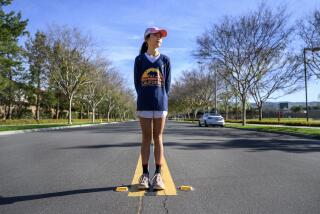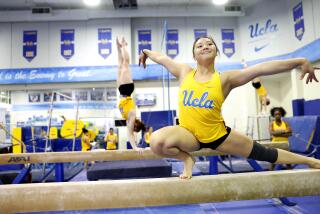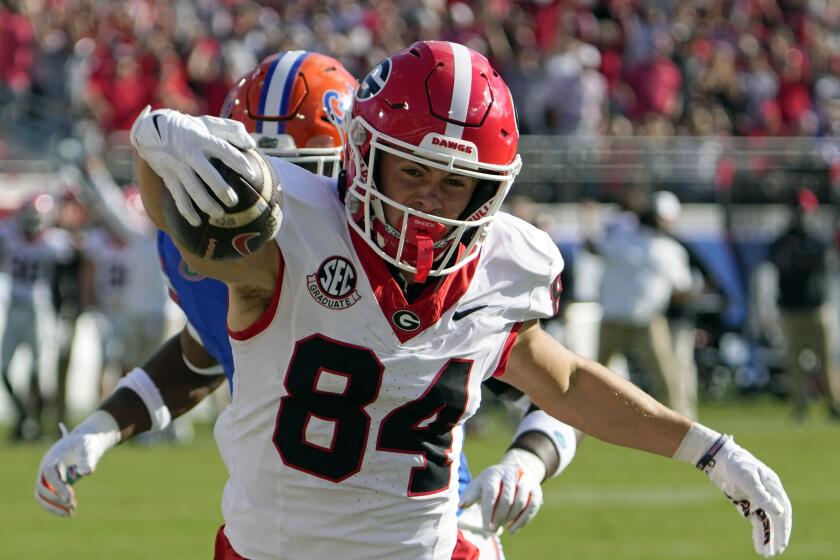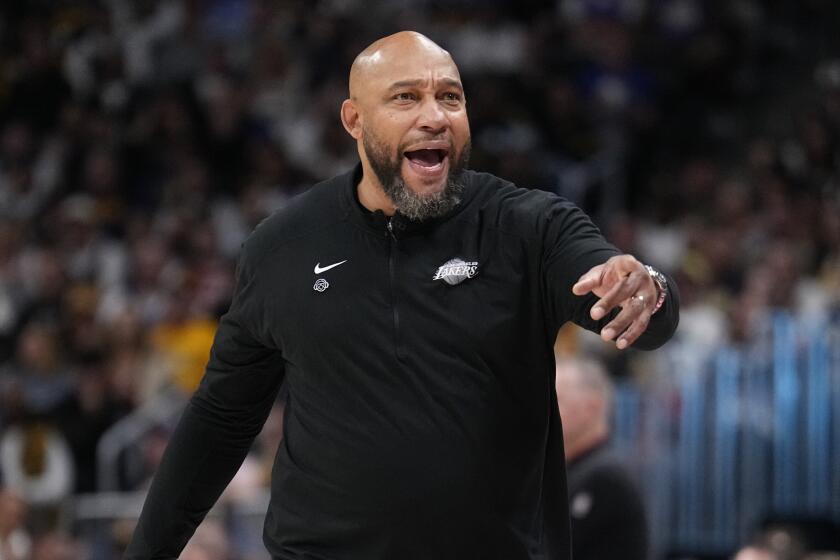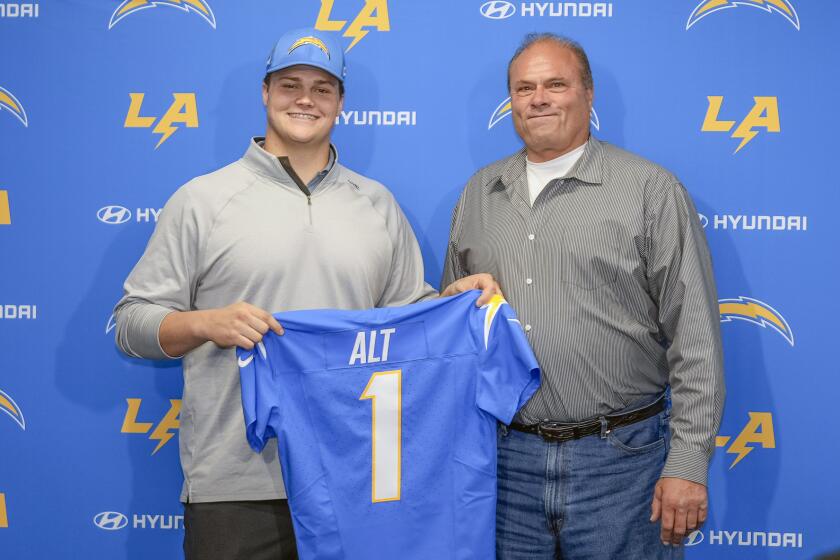U.S. distance runners get into tip-mountaintop shape for Olympics
Reporting from Mammoth Lakes -- Meb Keflezighi has been to the mountaintop.
And he liked it so much he decided to buy a house there.
That was 11 years, three daughters, one American record and an Olympic medal ago. Now Keflezighi is as comfortable at high altitude as the Abominable Snowman — and that, he says, is what made a lot of those other things possible.
“We had a vision to be able to change U.S. distance running by coming here,” says Keflezighi, the Olympic trials marathon champion and a medal hopeful at this summer’s Games in London. “And the vision came true. This was a distance runner’s heaven.”
Near the summit of the eastern slope of the Sierra Nevada, Mammoth Lakes is certainly a lot closer to heaven than Keflezighi’s former home in San Diego. But Keflezighi, a Christian who blesses himself twice and says a silent grace before every meal, wasn’t lured here by faith. He was drawn by science.
Physiologists long ago concluded that the thin air at high altitude causes the body to produce more oxygen-carrying blood cells, making athletes more efficient in endurance activities at lower levels. That also explains the dominance of East African marathoners, many of whom were born and raised in Kenya’s Rift Valley or the Ethiopian capital of Addis Ababa, both of which are more than 7,500 feet above sea level.
“When you anecdotally look at how many people are getting the medals and are training at altitude, there is enough evidence that most people shouldn’t overlook” it, says former UCLA track coach Bob Larsen, who has been coaching Keflezighi since he won four national titles for the Bruins in the late 1990s. “You have to conclude that if your red blood mass increases dramatically when you’ve been at altitude for a while, you’re going to have an advantage when you get to sea level.”
But since Keflezighi moved to this idyllic resort, he and Larsen have been pushing a corollary to that theory, one that says living above 7,500 feet and training anaerobically at about half that altitude will produce even better results. And few places are better suited to such a test than Mammoth Lakes, which sits at 7,880 feet and is just 35 miles from Bishop, which is only half as high.
“The beauty of Mammoth is the high-low,” says Keflezighi, who broke the U.S. record at 10,000 meters less than a year after moving to Mammoth. He then saw training partner Deena Kastor destroy the women’s national record in the same event the next spring. “For me, it’s been very successful.”
The area has long been a mecca for West Coast distance runners — Larsen, who skied here in the 1960s, used to bring his UCLA cross-country runners up for a week each summer. And Kastor, 39, visited with her Agoura High team in the 1980s.
“I’ve been traveling the world since I was 15 competing for this sport, and I haven’t found a place I like better,” says Kastor, a three-time Olympian who broke six national records and won a bronze medal in the Athens Games after moving to Mammoth from Alamosa, Colo., in 2001. “I love my job, I love where I live, and I think the combination is what allows me to be successful.”
Others have tried to copy that success, abandoning previously favored high-altitude haunts such as Boulder and Fort Collins, Colo., and Flagstaff, Ariz., swelling this city of 8,000, which is now home — at least part of the year — to more than a dozen national-caliber distance runners as well as cyclists, race walkers and triathletes. The U.S. Rowing team talked about moving its training camp to Mammoth, and runners from Japan, Hungary Kenya and Ethiopia have visited.
“This place is on the map on the elite side,” says Terrence Mahon, a former national-class runner who now coaches Kastor among others in the Mammoth stable. “We’re definitely getting more international.”
Partly because the air isn’t the only thing in Mammoth that’s breathtaking. The views are postcard perfect year-round, with snow-capped mountains jutting up on all sides in the winter. And in the summer, when the snow melts, it gives way to pristine running trails that wind around crystal-clear lakes.
“The scenery is amazing,” Keflezighi says. “Sometimes you just say ‘wow.’”
The community has embraced the athletes. Health-conscious restaurants serving vegetarian meals dot the strip malls along Main Street and Old Mammoth Road while just about everyone who lives here runs, bikes, skis or does a combination of the three. Even Dave McCoy, who founded the Mammoth Mountain Ski Area 70 years ago, was riding a mountain bike well into his 90s.
Then again with just one movie theater — versus three fitness clubs — there’s not much to do in Mammoth Lakes besides work out.
“There’s really not much going on,” says Morgan Uceny, the world’s top-ranked woman at 1,500 meters who splits her time between Mammoth and San Diego. “That allows you just to focus on what you’re doing in training and recovery and not a lot on outside factors.”
Call it a mountain high. But the elements can be as challenging as they are beautiful. On a recent March morning, the temperature had dropped below freezing, and the leading edge of a powerful storm had already dropped a blanket of snow on the ground by the time Keflezighi steered his three-year-old Infiniti — the one with the license plates that read RAN2WIN — into the frozen parking lot at Mammoth Creek Park.
Keflezighi, Kastor and about a dozen other brightly-dressed runners — including Uceny, former U.S. record-holder Anna Pierce, 10-time All-American Amy Hastings, Mahon, and his wife, three-time Olympian Jen Rhines — gather here at 8:30 most weekday mornings before dividing up and driving down the mountain to train. And it’s often the weather that separates the serious runners from those who see altitude as a shortcut to success.
“We all have lofty goals,” says a shivering Kastor, who is battling a cold but has shown up nonetheless. “We can’t let the weather stop us.”
Keflezighi, dressed in a long-sleeve white T-shirt tucked into black knee-length spandex shorts and wearing white gloves and a blue wool hat, climbs into the back seat of Larsen’s Jeep SUV and heads to a desolate stretch of flat pastures intersected by narrow paved roads and rocky dirt paths. No one in the group can keep up with Keflezighi on his tempo runs, so a coach on a mountain bike leads him through a pair of mile intervals followed by five one-kilometer repeats.
Keflezighi’s silver in Athens eight years ago is the only Olympic medal won by a U.S. male at a distance longer than 800 meters since Frank Shorter finished second in the 1976 marathon. Yet his lifetime best of 2 hours 9 minutes 8 seconds, run in January’s Olympic Trials, isn’t even among the 500 fastest marathons of all-time. It’s a subject that grates on Keflezighi, so as he lies on the pavement stretching after his workout, he calls out the names of faster marathoners whom he has beaten head to head. It’s a long list.
“People don’t care how fast you run. They want to know whether you medaled at the Olympics or won New York,” says Keflezighi, who has done both.
In Athens, for example, Keflezighi was the 38th fastest runner at the starting line but the second one across the finish line, beating world record holder Paul Tergat, among others. A week earlier, Kastor had finished third in the women’s race, making 2004 the only time Americans had medaled in both marathons.
Shalane Flanagan, who won the women’s trials, trains in Mammoth part of the year while Ryan Hall, who finished second in the men’s race, lived around the corner from Keflezighi until just recently. Hastings, meanwhile, finished fourth in the women’s race, making her an alternate for London while Kastor, who finished sixth, could still make the U.S. team in the 10,000 during this summer’s track trials. Uceny and Pierce will also try to qualify at the trials.
If everything breaks right, Mammoth Lakes could have seven of the 24 U.S. Olympians running flat races between 1,500 meters and the marathon.
And for Keflezighi, who escaped war-torn Eritrea when he was 10, it would be the realization of the goal he set when he first climbed the mountain in 2001: thanking his adopted homeland by raising the level of its distance runners.
“I have been very fortunate to achieve what I have achieved,” says Keflezighi who, at 36, is likely preparing for his last Olympics. “Running’s tough. It’s hard work; a lot of things have to go your way.
“My dream was to just have them elevate to the next level, the international level. It’s much stronger than it was.”
In fact, you might say they’ve reached new heights.
More to Read
Get our high school sports newsletter
Prep Rally is devoted to the SoCal high school sports experience, bringing you scores, stories and a behind-the-scenes look at what makes prep sports so popular.
You may occasionally receive promotional content from the Los Angeles Times.
